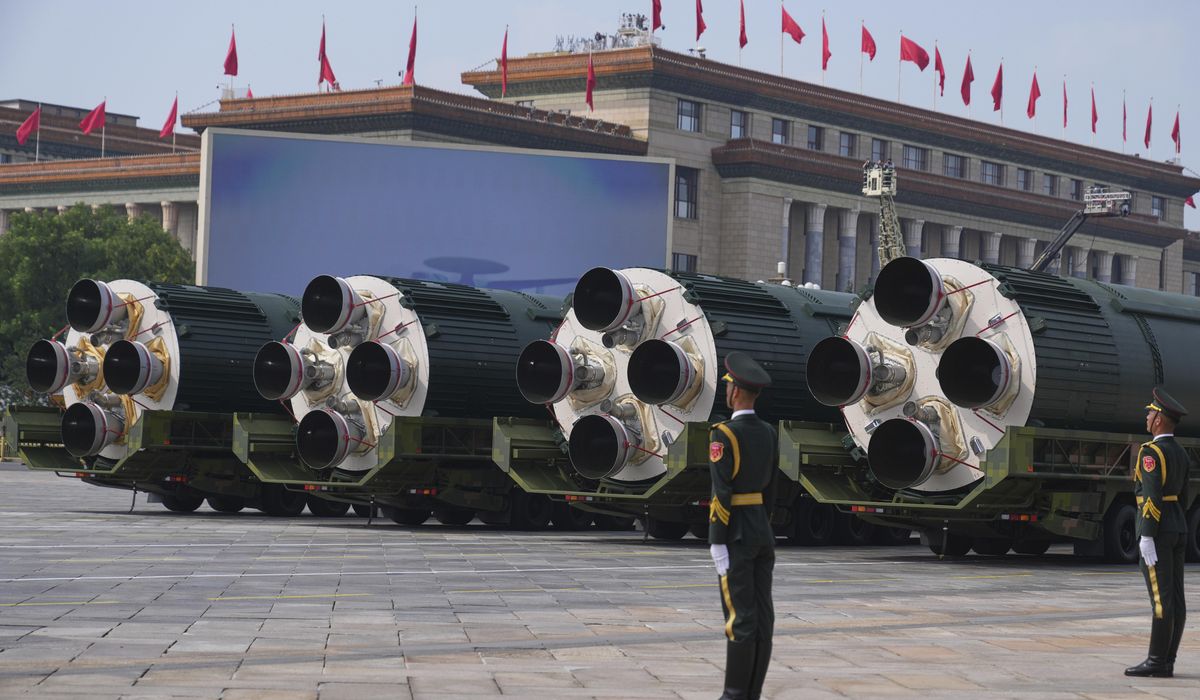


China’s rapid buildup of strategic forces is increasing, with the Pentagon now estimating Beijing’s military will have 1,500 nuclear warheads in less than five years, the general slated to be the next Air Force chief of staff told the Senate.
Air Force Gen. Kenneth F. Wilsbach disclosed the new estimate for future Chinese warhead growth in answers to questions posed by the Senate Armed Services Committee made public during a nomination hearing. He warned that the Chinese nuclear and missile threat is growing.
China’s “nuclear modernization and expansion will increase its ability to target our homeland with longer-range systems that can reach the continental United States, a primary reason to invest in Golden Dome,” he stated, referring to President Trump’s signature plan for strategic defenses.
The four-star general, who has headed the Air Force in the Indo-Pacific region and the Air Combat Command, said China’s rapid growth of nuclear arms includes both greater numbers of weapons and a large variety of new strike systems to deliver the warheads.
The general said he agreed with other military commanders who declared China’s nuclear expansion to be “breathtaking” in both speed and scale.
China, he stated, increased its nuclear arsenal from around 300 warheads in 2020 to 600 today, “with projections of 1,500 by 2030.”
That number of warheads would give China a comparable arsenal to that of the United States and Russia, each of which is estimated to have around 1,700 deployed warheads.
The Chinese warheads will be armed on a triad of systems — both silo-based and road-mobile ICBMs, submarine-launched missiles, and bombers capable of targeting the U.S. homeland, he said.
The new estimate of 1,500 Chinese nuclear warheads represents an increase of 500 warheads from the Pentagon’s most recent assessment.
The annual China military power report published in December stated China had surpassed 600 operational warheads as of mid-2024 and would have more than 1,000 operational nuclear warheads by 2030, many of which would be deployed at higher states of readiness than in the past.
Disclosure of the new warhead estimate follows a major show of Chinese nuclear power, including new strategic missiles, during a military parade in Beijing on Sept. 4.
The missiles included the first unveiling of a new DF-61 multi-warhead, heavy intercontinental ballistic missile, DF-5 ICBMs and several hypersonic missiles that can be armed with nuclear or conventional warheads.
“With projections of 1,500 warheads by 2035, China remains intent on modernizing, diversifying, and expanding its nuclear posture,” Gen. Wilsbach stated. “Over the next decade, China probably will continue to rapidly modernize, diversify, and expand its nuclear forces.”
Beijing is developing a more diverse nuclear force, made up of systems ranging from low-yield precision strike missiles to ICBMs with multi-megaton yields that will provide China’s communist leaders with options at every rung of the conflict-escalation ladder, he said.
“The threat to USAF forces and facilities from People’s Liberation Army Rocket Force are ever increasing due to the growing number, type, range and sophistication of missiles being produced year over year,” Gen. Wilsbach said.
Warheads are a key element of maintaining nuclear deterrence against attack.
Three large ICBM fields were recently built in western China that U.S. officials say contain more than 300 missiles with multiple warheads.
Gen. Wilsbach said that while the Air Force has made some progress in addressing the Chinese missile threat, a number of vulnerabilities remain.
Dispersing its forces in the western Pacific through a program called agile combat employment will make it harder for China to neutralize operations and increase the number of targets for Chinese war planners.
However, the Air Force needs to increase the hardening of facilities against attack to boost camouflage, concealment, and decoys; and to increase response options, he said.
Air and missile defense capabilities are insufficient to counter enemy missile capabilities and not optimized to protect dispersed bases, he said.
Russian nuclear forces also pose a threat, Gen. Wilsbach said.
Moscow suffered multiple failed tests of new weapons but is nearing completion of a major strategic modernization with most of its land-based and sea-based missiles and bombers upgraded, he said.
“Russia is driven by its desire to maintain parity with the U.S., counter U.S. missile defense systems, and compensate for conventional force weaknesses exacerbated by losses in Ukraine,” Gen. Wilsbach said.
“It maintains a stockpile of warheads, including deployed strategic warheads on ICBMs, SLBMs, and at bomber bases,” he said.
On China’s declared policy of not being the first to use nuclear weapons in a conflict, Gen. Wilsbach said many observers are skeptical that a no-first-use policy would be followed in a war.
It is not clear and under what conditions China could initiate the use of nuclear weapons in a future war, he said.
The Air Force chief nominee said the current nuclear deterrence policy and force structure “effectively accounts” for the growing nuclear threat environment that includes Russia, China and North Korea.
However, Russian and Chinese nuclear expansion means current U.S. strategic forces may be insufficient in the future, he said.
Gen. Wilsbach said modernizing the Air Force’s two legs of the U.S. nuclear triad remains the highest priority for the Pentagon.
The Air Force is in the process of replacing 400 aging Minuteman III ICBMs with the new Sentinel ICBM, which is facing delays and cost overruns.
The Air Force’s new stealth bomber, the B-21, is in production with at least 100 aircraft to be built.
Gen. Wilsbach testified during the committee hearing that as chief, he will remain committed to pushing through the modernization of the Sentinel, B-21, along with a new nuclear command and control system.
“Our nation relies on its Air Force to deliver air superiority, nuclear and conventional global strike, rapid mobility, command and control, and intelligence, surveillance, and reconnaissance,” he said. “These are no-fail missions. They are critical to our national security, particularly in an increasingly dangerous world.”
• Bill Gertz can be reached at bgertz@washingtontimes.com.
